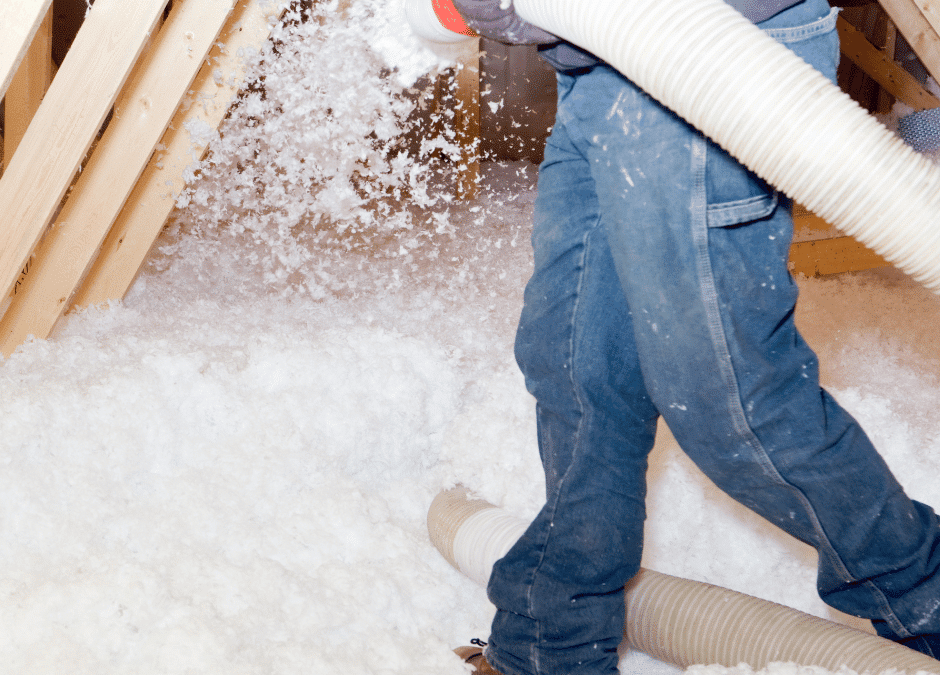Insulation is a pivotal aspect of eco-friendly buildings, playing a crucial role in energy efficiency and comfort. In this comprehensive guide, we delve into the pros and cons of two popular insulation types: blown-in fiberglass and blown-in cellulose. Green Smart Insulation brings you an in-depth comparison to help you make an informed choice for your home.
What is Blown-In Insulation?
Blown-in insulation, a cutting-edge method in the insulation industry, involves mechanically inserting insulation materials into wall cavities, attics, and hard-to-reach areas. This method ensures a snug, comprehensive coverage, significantly reducing energy leaks compared to standard batt insulation. We examine two prevalent materials: blown-in fiberglass and cellulose. Each possesses distinct characteristics, offering a range of benefits tailored to different needs.
The Basics of Blown-In Fiberglass
Blown-in fiberglass insulation consists of finely spun glass fibers, offering superb thermal resistance. Its lightweight, durable composition makes installation easy and ideal for various spaces. Especially effective in damp conditions due to its moisture resistance, fiberglass also adds a layer of fire safety, making it a preferred option for enhancing home safety and comfort.
The Basics of Blown-In Cellulose
Blown-in cellulose, made primarily from recycled paper, is an eco-conscious insulation choice. It’s treated with fire retardants for safety and is highly efficient in energy conservation. Cellulose not only excels in thermal insulation but also provides excellent soundproofing, making it ideal for creating a quiet, energy-efficient home environment.
Pros of Blown-In Fiberglass Insulation
Blown-in fiberglass insulation offers numerous benefits. It’s highly resistant to moisture, reducing mold and mildew risks and ensuring healthy indoor air. Its non-combustible nature enhances fire safety, making it suitable for various climates. Fiberglass maintains its insulation properties over time, providing long-term energy savings. It’s durable, doesn’t settle significantly, and remains effective for years, making it a reliable and cost-effective insulation solution.
Cons of Blown-In Fiberglass Insulation
Despite its advantages, blown-in fiberglass has downsides. Its production is less eco-friendly, involving high energy consumption and less sustainable materials, a concern for eco-conscious individuals. The installation poses health risks due to fine glass particles, requiring protective measures. Additionally, the initial cost can be higher than other insulation types, affecting budget considerations. These aspects are important to evaluate for those balancing environmental and health impacts with insulation benefits.
Pros of Blown-In Cellulose Insulation
Blown-in cellulose insulation excels in thermal performance, significantly enhancing energy efficiency. Made primarily from recycled paper, it’s an environmentally friendly choice, reducing waste and supporting sustainable building practices. Additionally, cellulose offers excellent soundproofing capabilities, ideal for creating a quieter, more serene indoor environment. It’s also more cost-effective than some alternatives, making it a budget-friendly option without compromising on quality or effectiveness.
Cons of Blown-In Cellulose Insulation
Blown-in cellulose insulation, while efficient, has drawbacks. Its propensity to absorb moisture can lead to mold issues, particularly in humid conditions. Over time, cellulose may settle, reducing its insulative effectiveness and potentially requiring additional applications. Although treated for fire resistance, it lacks the inherent fire-retardant qualities of fiberglass, necessitating chemical treatments. These aspects should be weighed against its benefits when considering insulation options.
Comparative Analysis: Fiberglass vs. Cellulose
When considering insulation options, it’s crucial to weigh the characteristics and benefits of each material. Here’s a comparative analysis of blown-in fiberglass and cellulose, broken down into key points to help you make an informed decision:
- Moisture Resistance: Fiberglass is highly resistant to moisture, making it less prone to mold and mildew. This feature is particularly beneficial in humid climates or areas prone to water exposure.
- Fire Safety: Fiberglass is non-combustible, offering an added layer of fire safety. Cellulose, though treated for fire resistance, does not naturally possess the same level of fire retardancy.
- Environmental Impact: Cellulose stands out for its eco-friendliness, primarily made from recycled materials. Fiberglass, on the other hand, has a higher environmental impact due to its manufacturing process.
- Installation Health Risks: Installing fiberglass requires caution due to the fine glass particles that can pose health risks. Cellulose is generally safer to install, with fewer health concerns.
- Cost Considerations: Cellulose is often more cost-effective upfront, making it a budget-friendly option. Fiberglass, while potentially more expensive initially, offers long-term savings due to its durability.
- Thermal Efficiency: Cellulose typically provides superior thermal performance, enhancing energy efficiency. Fiberglass also offers good insulation but may not perform as well as cellulose in thermal tests.
Installation Process and Considerations
The installation of both fiberglass and cellulose involves specialized equipment and expertise. Fiberglass requires careful handling to avoid irritation from the glass fibers, while cellulose demands precise installation to prevent settling. Green Smart Insulation ensures a seamless and safe installation process, regardless of your choice.
Green Smart Insulation’s Approach
At Green Smart Insulation, we specialize in providing tailored insulation solutions. Our team of experts assesses each home’s specific needs, advising on the best insulation type. Whether you choose fiberglass or cellulose, we ensure a professional, efficient installation that aligns with your home’s energy efficiency goals.
Contact Us for Your Insulation Needs
Choosing the right insulation for your home is a decision that balances environmental concerns, safety, and budget. Green Smart Insulation is here to guide you through this choice. Our expertise in both blown-in fiberglass and cellulose insulation ensures that you get the most suitable, efficient, and cost-effective solution for your home. Reach out to us to discover how we can transform your living space into an eco-friendly, energy-efficient haven.


Recent Comments